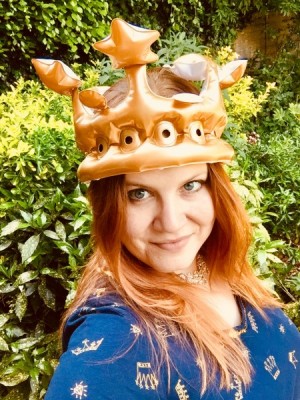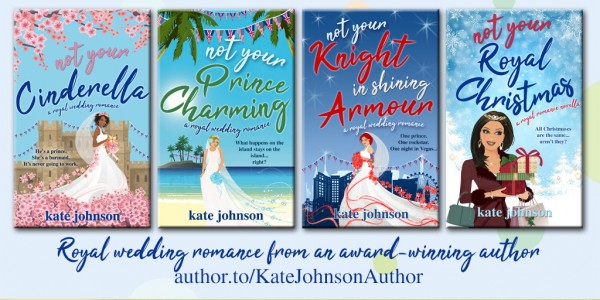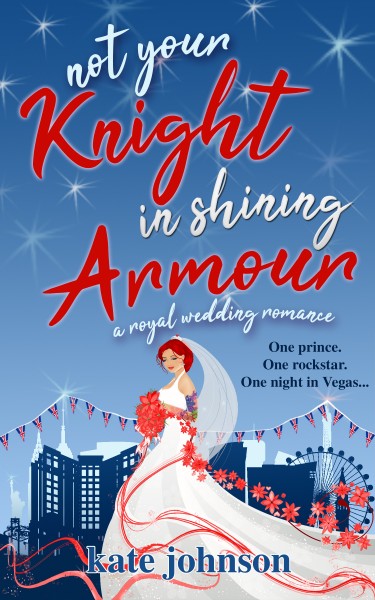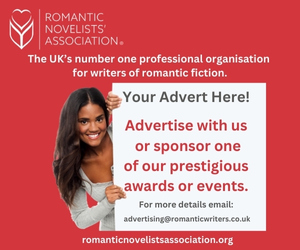Kate Johnson: Is Your Book Cover Right For Your Readers?
21 February 2019
 Kate Johnson is a hybrid author, with traditional and indie-published titles to her name. She’s written across a range of genres – from contemporary to paranormal to erotica to romcom. Her most recent series is about royal weddings and Not Your Knight in Shining Armour is published today. Kate’s here to tell us about redesigning covers for the market.
Kate Johnson is a hybrid author, with traditional and indie-published titles to her name. She’s written across a range of genres – from contemporary to paranormal to erotica to romcom. Her most recent series is about royal weddings and Not Your Knight in Shining Armour is published today. Kate’s here to tell us about redesigning covers for the market.
Covers are little coded messages, shorthand for what’s inside—and they’re market specific. Look at the best-selling contemporary romances on Amazon US and UK and notice the differences. In America, it’s all photographic images. Sometimes of a couple—usually in a clinch—and often of a man by himself, not wearing very much and looking a bit unhappy about it. Look at the UK covers, and it’s all illustrations of pretty villages and flowers and maybe a woman looking kooky and fun.
My Royal Wedding covers… didn’t look like either of those.
The story that became Not Your Cinderella had been in my head for a while, one of many I entertain myself with that will probably never get written. At the time I was focusing on paranormal romance, and a contemporary romance about a prince wasn’t part of the brand I was trying to create.
But then Prince Harry’s engagement was announced and that story came back into my mind. There’s kind of a limited market for action romance in space, so I figured I ought to try something commercial, and here was the perfect opportunity.
But let’s go back to that word: brand. My last two books were action sci-fi, set in space and full of fight scenes and explosions. When I made the covers for them, I wanted them to reflect that, so I chose bold fonts in shades of molten metal for my name, and images of things going boom.
Literally nothing goes boom in this book—except for a few hearts.
I made US and UK mock-ups for Not Your Cinderella. I hated both. My hero simply didn’t look like any of those muscular bare-chested men—he’s a video-gaming computer scientist whose glasses are always smudged—and there simply weren’t any cute villages or flowers in the book (not to mention the impossibility of finding a cute stock image of a mixed-race couple).
 So I found an image of an engagement ring that looked like a crown. Perfect! Give that a plain background—say, purple, for royalty—and add some punky hot pink touches for my council-estate heroine. Great, a cover that reflects my book.
So I found an image of an engagement ring that looked like a crown. Perfect! Give that a plain background—say, purple, for royalty—and add some punky hot pink touches for my council-estate heroine. Great, a cover that reflects my book.
But here’s the thing. People looking at that cover on Amazon don’t know that it reflects the book. They don’t know what that cover means.
Now, if I were the graphic designer for a big publisher and I wanted to create a bold new look for an exciting new book, I could probably throw a lot of money at it and make it work. But I’m not: I can’t tell the market what it wants. That’s the lesson I learned. You’ve got to accumulate before you can speculate. Or something.
The reaction I got to the covers—because by this point I realised it would be a series—was polite at best. A couple of reviewers were less polite: ‘godawful cover’ was the phrase one used. And I began to run out of variations. By the time I got to Not Your Knight in Shining Armour, I couldn’t find a colour combination I hadn’t used that even remotely worked for the book.
So I threw a hissy fit and sulked.
And then I swallowed my pride, went back to my computer and made some decisions. I couldn’t make a cover that looked right for both the US and the UK market, so I had to make a choice. I chose the UK market. And I spent days—weeks, maybe—trawling stock image sites for something I didn’t hate, that would look appropriate for the market, that also represented my books.
 In the end I used several images for the Not Your Cinderella cover, but the crucial two were by the same designer. The bride in that image is a blonde chick, but she also had a collection of women of all races and backgrounds in different situations, drawn in the same style. So I used my Photoshop skills (sign of a misspent youth right there) to put them together to make Clodagh—who is mixed race with very curly natural hair.
In the end I used several images for the Not Your Cinderella cover, but the crucial two were by the same designer. The bride in that image is a blonde chick, but she also had a collection of women of all races and backgrounds in different situations, drawn in the same style. So I used my Photoshop skills (sign of a misspent youth right there) to put them together to make Clodagh—who is mixed race with very curly natural hair.
And all the time I kept going back to Amazon to see what else the cover needed. I looked at the covers on the RoNA shortlists for the last couple of years. And eventually, I came up with something I liked, something that represented the book—and most importantly, something that looked like a British contemporary romance.
And then I did it again for the sequels…
Thanks, Kate – it’s really interesting to hear about what goes into choosing and designing covers. The new covers are lovely!
And now for some questions…
Writing across several different genres, do you find that you have some readers who will follow you whatever genre you write in? How do you, as a writer, shift gears between genres – do you read in that genre, or do the stories and characters come along and carry you away?
I read in a lot of genres, so that part isn’t hard! Although it doesn’t always follow, because the genre balance of what I read and write is quite different: I read lots of historicals and YA and non-romance, and haven’t written them (which isn’t to say I might not one day).
To me, it’s not really all that different, because essentially I’m writing romance and that’s it. Sometimes it’s set in the here and now, and sometimes it’s set on a spaceship or an alternate world. I do have loyal readers who follow me from genre to genre, which is ace, and sometimes I get comments like, “I wouldn’t have read this if I didn’t already like your other books,” which is a bit of a backhanded compliment when you think about it, but I’ll take it!
 The fourth instalment in your Royal Wedding Romance series is out today. Each title has been very different, from a kidnapped princess to a widowed countess to a prince working on his PhD. Do you have more royal couples on the way, who will similarly challenge the traditional view of what a royal could or should be?
The fourth instalment in your Royal Wedding Romance series is out today. Each title has been very different, from a kidnapped princess to a widowed countess to a prince working on his PhD. Do you have more royal couples on the way, who will similarly challenge the traditional view of what a royal could or should be?
As it stands, Tom and Scarlet are the last royal wedding I had planned. To be honest, I didn’t plan more than one, but then Princess Eugenie announced her wedding and, well, I couldn’t help myself…
Every book has been about the people you don’t expect to be part of a royal wedding. One of the things I find fascinating about the royals is how they’re simultaneously the same as they’ve always been and always evolving. They absorb outsiders and present them as if things have always been this way. A generation ago it seemed entirely ordinary that a prince should marry a woman half his age he’d barely met, purely on the basis she was from the right sort of background. But the twenty-first century royal weddings have been between people who’ve met and fallen in love at university, or through the course of their work or shared interests. You know, like normal people. We’ve got an actress, a rugby player, and the daughter of an air hostess all married to grandchildren of the Queen, and no royal eyebrows were raised—at least publicly.
So I guess I started wondering what did happen behind closed doors when those proposals were put forward to the Queen (at the time, all the Queen’s descendants had to ask her permission to marry). What sort of person would cause the royal eyebrows to go up? What would make her consider saying no? And then I made those people fall in love with royals.
As for the future? Well, I’ve slightly run out of royals to marry off. But since I had my kidnapped princess fall in love with a Miami cop, I did wonder if it might be fun to have him solving crimes in future. Stolen crown jewels! A missing corgi! And it would let me explore the characters I’ve already introduced—specifically Princess Drina who… well, I won’t spoil what she’s going to reveal in Not Your Knight in Shining Armour, but let’s jus say if she got married it really would raise a few eyebrows.
In Not Your Knight in Shining Armour, readers will meet a prince with PTSD and a heroine who’s a recovering alcoholic. Prince Harry has talked publicly about flashbacks he’s had since being in combat – did this inspire your hero’s PTSD? Was this a dark instalment to write, or is it empowering writing about challenges people face and guaranteeing them a happy ending in a romance?
One way or another, the current younger generation of royals have informed a lot that went on in these books. (Although some bits came as a surprise to me: my kidnapped princess choses a wedding dress that won’t conceal the scars she has from her ordeal, and blow me if Princess Eugenie didn’t make a point of revealing her scoliosis scar in her wedding dress!)
That Prince Harry has talked publicly about mental health issues—it’s been an issue William has addressed too—was important for this book, because one of the things people often misunderstand about mental health is that it can hit anyone, and privilege isn’t any kind of vaccination or cure for it. “You’re a prince, what have you got to be depressed about?” is one of the key issues Tom is struggling with.
I think one of the things that stuck in my head when I wrote Tom was a little clip that was being shared around when Prince Harry got married. In it, he’s in combat gear on some military base—clearly on active service—and giving an interview to camera. Suddenly, there’s a kerfuffle in the background, and he glances back, and before you can breathe he’s already moving, grabbing his gear and leaping onto an aircraft. The interview is forgotten instantly as he rushes off to do his duty. In that clip, he’s a soldier first, and a prince second. I think that’s what I wanted to get across with Tom: being a Navy pilot is much more a part of his identity than being a prince, and when that’s taken away from him he doesn’t quite know how to cope.
Your romantic comedy Little Haunting by the Sea was published on Hallowe’en last year. Hailing from Yorkshire and now living in Essex, I suspect there’s several seaside towns you’ve been able to draw on to create Little Haunting – which ones helped to inspire you? (I became trapped in the mirror-maze on Walton pier as a teen, which was definitely a terrifying experience!)
I have to admit the place that inspired Wirpness-on-Sea isn’t in either Yorkshire or Essex! It’s Southwold, in Suffolk, and it’s a picture-perfect seaside town that seems to exist in a little bubble of nostalgia. How could anything frightening happen there? Well, frightening things happen everywhere… (cue scary music).
The thing that’s so fascinating about seaside resorts is that we play on the beach and eat ice cream and drink beer, and yet a few feet away is one of the most deadly things on the planet. The sea can kill you in a million different ways, and no matter how pretty the beach huts are, or how fun the pier is, or how tasty the local beer (Southwold has its own brewery and distillery, a fact which makes the lack of alcohol-releated deaths there astonishing), it’s still there. I went to Filey this last summer, and there were a few signs around telling you not to walk along the Coble (the sea wall) when the tide was coming in—but nothing to actually stop you doing it. Now how could you not set a ghost story there!
Thanks for being on the blog today, Kate – and happy publication day!
About the author
Kate has a second cousin who held a Guinness World Record for brewing the world’s strongest beer, and once ran over herself with a Segway scooter. She misspent her youth watching lots of Joss Whedon and reading even more Terry Pratchett, which made it kind of inevitable that when she grew up to write romance novels, they’d be the weird ones around the edges. A few years later, she lives with a pride of beloved cats in the south of England. She still loves Joss Whedon and Terry Pratchett.
In 2017 Kate became the first author to win a Paranormal Romantic Novel of the Year Award from the Romantic Novelists Association, with Max Seventeen, which was also the first self-published book to win in any category. She has been shortlisted twice more, for The Untied Kingdom and Max Seventeen: Firebrand.
Find Not Your Knight in Shining Armour on Amazon, and see all of Kate’s books on her Amazon author page.
Follow Kate on Twitter, Facebook and Pinterest, and to find out more about Kate and her writing, visit Kate’s website.
 About the interviewer: Eleanor Harkstead is from the south-east of England and now lives somewhere in the Midlands. She has a large ginger cat who resembles a Viking. Her m/m romantic fiction, co-written with Catherine Curzon, spans WW1 to the present day and is published by Pride. Historical paranormal series The de Chastelaine Chronicles will be unleashed this Spring by Totally Bound. Catherine and Eleanor have just launched the Gin & Gentlemen podcast. You can find out more about Eleanor at her website: curzonharkstead.co.uk, on Twitter, Facebook, and Instagram.
About the interviewer: Eleanor Harkstead is from the south-east of England and now lives somewhere in the Midlands. She has a large ginger cat who resembles a Viking. Her m/m romantic fiction, co-written with Catherine Curzon, spans WW1 to the present day and is published by Pride. Historical paranormal series The de Chastelaine Chronicles will be unleashed this Spring by Totally Bound. Catherine and Eleanor have just launched the Gin & Gentlemen podcast. You can find out more about Eleanor at her website: curzonharkstead.co.uk, on Twitter, Facebook, and Instagram.



